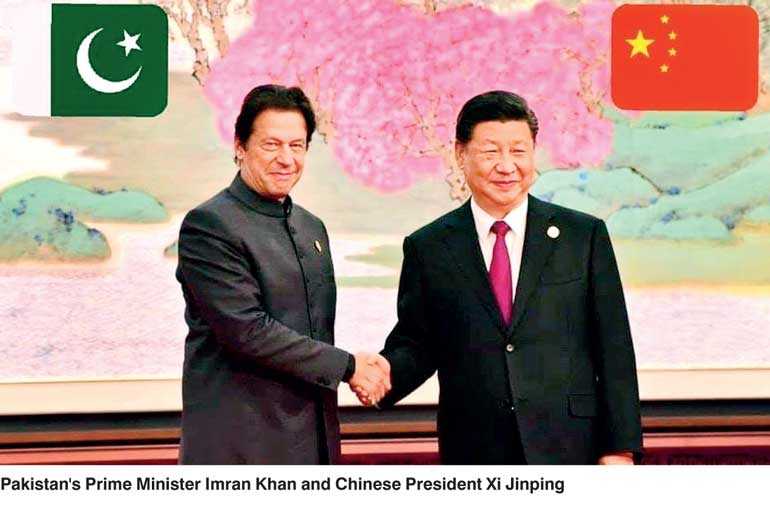Saturday Dec 20, 2025
Saturday Dec 20, 2025
Saturday, 10 November 2018 00:10 - - {{hitsCtrl.values.hits}}

 With the US and the IMF acting tough, Pakistan’s time-tested friends, Saudi Arabia and China, have come to its rescue at a time when its economy is in dire straits.
With the US and the IMF acting tough, Pakistan’s time-tested friends, Saudi Arabia and China, have come to its rescue at a time when its economy is in dire straits.
The woes of Pakistan’s economy are many. The Pakistani Rupee has been devalued four times since December 2017. According to published sources, a similar scenario in 2013 had led to Pakistan’s obtaining a $ 6.7 billion loan from the IMF. Foreign reserves have dwindled to $ 7.7 billion from $ 16.4 billion in May 2017. This is barely enough for seven weeks of imports.
Pakistan’s current account deficit widened by 43% to $ 18 billion in the fiscal year that ended 30 June, while the fiscal deficit had increased 6.8%, financial reports said.
No wonder Imran said after taking over as Prime Minister: “Pakistan is facing the biggest economic challenge in the country’s history. Our economy is going down because of our dysfunctional institutions. We need to fix our governance systems.”
Indeed, the ultimate solution is in reform of the overall Pakistani system which is corrupt and dysfunctional to the core. But the need for an immediate financial bailout cannot be gainsaid.
Pakistan has taken 12 packages from the IMF since the late 1980s. It is believed to be seeking between $ 10 billion and $ 15 billion from the IMF.
But IMF loans come with tough conditions such as reining in fiscal deficits, adoption of a tighter monetary policy and reformation of the basic structure of the economy. The tax net has to be widened and tax collection will have to be improved. Prices of utilities will have to be raised. Knowing this, Pakistan’s Central Bank has already increased interest rates three times this year to 7.5%.
The US-led IMF has threatened to ask Pakistan to reveal the terms of its debt to China and cut down on projects linked to the China-funded multi-billion dollar China-Pakistan Economic Corridor (CPEC), which Washington describes as a “debt trap”.
The Trump administration has clearly stated that it will not disburse funds to help Pakistan if the objective is basically to repay its debt to China.
On the other hand, China is also acting tough. Its official spokesman has said that while Beijing is ready for a “professional” assessment of its project funding in Pakistan, it will not tolerate any dilution of CPEC.
China has also said that Chinese loans are only a small part of Pakistan’s overall debt to the outside world and that it is not responsible for Pakistan’s overall debt crisis.
Help from Riyadh and Beijing
Be that as it may, armed with a $ 6 billion package from Saudi Arabia, and a $ 1 billion in immediate help from China, the beleaguered Pakistani Prime Minister Imran Khan hopes to face the IMF team with greater bargaining power.
Saudi Arabia has told Imran Khan that it will deposit $ 3 billion for one year as Balance of Payment support. It will also provide a one-year deferred payment facility for the import of oil up to $ 3 billion. The latter arrangement is to be in place for three years followed by a review.
The Saudis are to invest in a petroleum refinery in Pakistan. They have also expressed interest in the development of mineral resources in that country.
Stressing the need to focus on human resource development (Pakistan has to generate 1.3 million jobs a year to meet the demand of a growing and increasingly youthful population), Imran Khan told the Saudis about the need to invest in the tourism sector, minerals, coal and gas exploration and information technology to generate jobs. They were also asked to invest in the Special Economic Zones coming up as part of CPEC.
After his successful visit to Riyadh, Imran went to China on a five-day visit. Beijing did not announce a bonanza, but it told Imran that it would help Pakistan tide over the financial crisis.
Chinese Vice Foreign Minister Kong Xuanyou had told the media that the “in principle the Chinese Government will provide necessary support and assistance to Pakistan in tiding over the current economic difficulties. As for the specific measures to be taken, competent authorities of the two sides will have detailed discussions.”
More concretely, Beijing gave Islamabad a $ 1 billion worth of duty-free access to the Chinese market. According to Abdul Razak Dawood, Imran’s Advisor on Commerce, this will “double Pakistan’s exports in a year”.
The Chinese also told the Pakistani team that if Pakistanis use the market access facility well, access will be increased to the tune of $ 2 billion in 2019.
This facility is timely. Pakistan’s exports had been going down for five years before starting a recovery in 2017. Pakistan had a $ 37 billion trade deficit, the highest-ever, in the last fiscal year.
Nearly half of the deficit was because of the trade imbalance with China. Last year, Pakistan’s exports to China were a measly $ 1.2 billion against the import of $ 14.5 billion worth of goods from China.
A Pakistani delegation was expected to hold talks with Chinese authorities in Beijing on 9 November to finalise details of market access and a possible Balance of Payments support program.
Task force on financial needs
Notably, for the first time, China has set up a ‘task force’ to assess Pakistan’s financial needs, according to a statement issued by the Pakistani Ministry of Finance.
China has already been helping in this sphere. This year, China had placed $ 2 billion with the State Bank of Pakistan (SBP) to beef up foreign exchange reserves. Earlier in May, China had given $ 500 million as Balance of Payments support. Chinese commercial banks have also been giving big loans to Pakistan.
One of the most important consequences of Imran’s five-day China visit is the interest shown by the Chinese in investing in agriculture which is one of the pillars of the Pakistani economy and a major employment generator. Imran Khan is using Pakistan’s low-cost labour to sell the idea that investment in agriculture for export will be a good idea.
New direction for CPEC
Pakistan and China have completed the first phase of CPEC, which comprised infrastructure and energy sector development. In the second stage, attention is to be given to industrialisation, agricultural revitalisation and trade integration. This phase will help job creation and export growth.